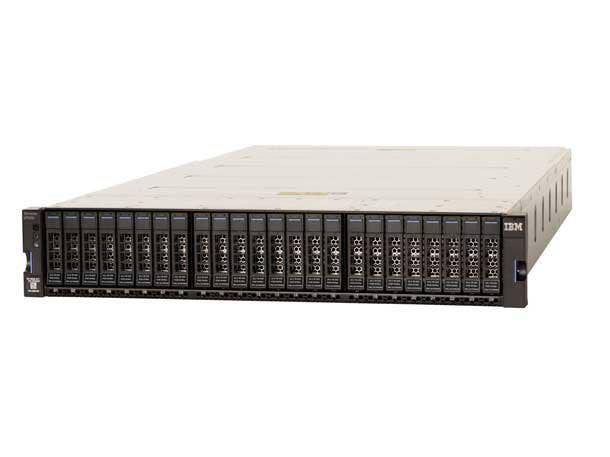IBM Doubles Down On Flash, NVMe As It Commits To Taking Storwize 100 Percent Through Channel

IBM is beefing up its enterprise storage line with the introduction Tuesday of new all-flash storage arrays including an expansion of its end-to-end NVMe offerings.
Big Blue is also looking to increase its reach into the storage market with a commitment to make its Storwize line available exclusively through its indirect sales channel partners.
The moves come as IBM is experiencing a slowing down in its overall storage business even as it ramps up its flash storage sales. When the company last week reported its third fiscal quarter 2018 financials, it said its storage hardware business declined in the quarter, but that decline was mitigated with what it called strong growth in all-flash array sales.
[Related: 22 Flash Storage Products Heating Up The Data Center Market]
Even so, IBM still has room to grow its flash storage business. In the second quarter of 2018, IBM saw year-over-year growth in all-flash storage sales of 14.4 percent, but that was the smallest year-over-year growth of the top seven vendors.
IBM wants the channel to take a more active role in its storage business by taking its entire Storwize line sales through channel partners, said Eric Herzog, chief marketing officer and vice president of worldwide storage channels for IBM's Storage Division.
Until now, between 65 percent and 70 percent of IBM's Storwize business globally has gone through indirect channels, Herzog told CRN. With this, Storwize joins IBM's VersaStack converged infrastructure offering as a channel-only offering, he said.
Going forward, IBM will be adding more resources to help channel partners sell Storwize, but the programs, margins, and marketing and tech support will remain unchanged, Herzog said.
The move to make IBM's Storwize line available only through channel partners is a huge move for IBM, said Phil Godwin, president and chief operating officer at Clear Technologies, a Dallas-based solution provider and 25-year IBM business partner.
"IBM is very committed to the channel," Godwin told CRN. "Storwize is already heavy on the channel side. By saying it is now 100-percent channel, IBM is giving reassurances to its channel partners. And it provides a lot of expansion opportunities in clients where we can grow our market share."
On the technology side, IBM is doubling down on flash storage, with a particular emphasis on NVMe, Herzog said.
First, IBM is introducing the new NVMe-based Storwize V7000 generation 3 featuring NVMe interface built into the array itself. It is expected to start shipping right after Thanksgiving, but channel partner can immediately start taking orders for it, Herzog said.
IBM has also invested heavily in software-defined storage, and in 2019 is planning to ship IBM Cloud Object Storage, its first software-defined storage application to support the NVMe-based Storwize V7000, he said.
The second big flash investment unveiled by IBM is the doubling of the flash storage capacity of the company's FlashSystem 9100 and its Flash System 900, Herzog said.
The FlashSystem 9100 was introduced in July as IBM's first storage system to feature embedded high-performance NVMe storage capacity along with the full complement of IBM's storage software and new storage "blueprints" to help partners build multi-cloud solutions.
The new FlashSystem 9100 supports both IBM's proprietary high-performance FlashCore flash storage modules as well as industry-standard SSDs, and comes with Storage Insights, IBM's artificial intelligence-powered analytics software.
The FlashSystem 9100 features IBM's FlashCore flash storage modules which are proprietary modules featuring both flash storage capacity and hardware-accelerated I/O. IBM is also introducing new NVMe-based FlashCore modules for the FlashSystem 9100, and will also make those modules available with the Storwize V7000, Herzog said.
IBM's embracing of NVMe is important because NVMe is the future of storage, Godwin said.
"IBM has made a big commitment to NVME," he said. "This gives them a great position in the marketplace. And with the increase in performance, IBM has taken care of increasing needs for power to handle things like deduplication."
IBM also expanded its data and storage management software with the introduction of IBM Spectrum Discover, which uses the metadata of unstructured data to improve data analytics, governance, and compliance.
IBM Spectrum Discover automatically creates a catalog of unstructured data as it is ingested, and provides an API for application software vendors to take advantage of that data even at exabytes of capacity, Herzog said. By year end, it is slated to support IBM's Cloud Object Storage and Spectrum Scale applications, and next year is slated to support Dell EMC's Isilon technology, he said.
IBM is also making a bid for artificial intelligence by developing reference architectures that combine IBM Power servers and IBM storage, Herzog said. The company plans to add Nvidia GPUs to the reference architecture sometime early 2019, he said. It will be a channel-centric offering, he said.